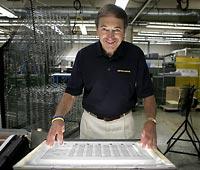China clocks in with Seattle manufacturer

Three clocks decorate the lobby at the Seattle headquarters of family-owned manufacturer GM Nameplate, indicating the company's international reach of eight plants in three time zones.
A nameplate for China is to be added under the clock that shows the time in Singapore.
The second clock shows the time in Seattle, Oregon, California and British Columbia. The third displays the time in North Carolina.
One of the largest privately owned companies (by revenue) in the state, GM Nameplate makes labels for laptops, washers, cars, medical devices and airplanes.
Each of the company's plants has opened for the same reason: "Follow the customers," as Don Root, chairman and chief executive, puts it.
The 10,000-square-foot plant in Guangdong, mainland China's southernmost province, was opened to reduce costs and deliver faster to big customers in that country.
Expanding to Asia was not new to Root, who opened a plant in 1997 in Singapore, mostly to serve Hewlett-Packard.
The Seattle headquarters and a 140,000-square-foot manufacturing plant are housed in one building across 15th Avenue West from a 25,000-square-foot SuperGraphics plant.
Root, 69, says the company will remain in Seattle, where Lester Green and Beale McCulloch started it, but he wants to sell the two buildings and consolidate into one.
The company wants to be near its largest customer, Boeing. A team of more than 50 employees is devoted to the Boeing account.
Root says he considered opening a plant in China in 2000 when he saw many customers outsourcing jobs and manufacturing to Asia.
Plans to have a Mexico plant fell through in 2000, and the company decided to concentrate on China.
Nelson Dong, partner at Dorsey and Whitney law firm in Seattle, worked with colleagues in Hong Kong to get a business license for GM Nameplate. That took about nine months.
"The important thing for American businesses to know is that China is a much more regulated society," Dong said.
The company needed the local license, which would have taken about two months. But it also needed a printing license approved by the national government in Beijing. That took much longer.
The 10,000-square-foot plant in China, in an industrial district in Dongguan, has about 50 employees.
From China, the company will be able to serve customers better and faster, said Erwin Limowa, managing director of the China division.
"[China is] very different," Limowa said. "For one thing, people here, they work around the clock. It's very common to be receiving calls in the middle of the night."
Factories in China commonly run three shifts, he said. GM Nameplate's China division runs one shift Monday through Saturday and is hiring 15 workers for the second shift.
"If a customer wants a part tomorrow, and they give you something today, you've got to act on it," Limowa said.
The Chinese employees earn 60 cents to $1 an hour, including benefits like food and housing. Managers get about $4 an hour, Limowa said.
The company's factory workers in the U.S. make $11 to $34.50, including benefits, Root said.
"So you can see why companies have gone offshore to get things manufactured," Root said. "I don't like it, but they have to compete."
On a recent tour of the Seattle plants, the effects of globalization were evident.
Handheld waterproof computers used to survey construction jobs were being assembled.
"We've been making these for about five years, and this model is ending its life," Root said. "We at least get to keep [making] the molding."
The molding cases also will still be made in Oregon and shipped to Mexico, where the computers will be assembled.
"That's what's happening with the manufacturing in the U.S.," Root said.
In one headquarters room, K2 skis leaned against the wall, a reminder of another logo the company once manufactured. (K2, once based on Vashon Island, moved its headquarters to California and sent hundreds of production jobs to China in 1999.)
Across the street from the headquarters is SuperGraphics, a plant that opened in 1999. Huge posters atop the building — of airplanes and the monorail — showcase the plant's graphics work.
Keeping up with industry trends, Root bought a digital printing press with UV ink and light that can print on glass, plastic, wood and metal. He knew digital graphics would eventually replace a fair amount of screen printing.
When Root bought the company in 1977, it had 65 employees and $3.8 million in revenue. By 2000, revenue had risen more than 20-fold.
Revenue and profit plunged after 9/11 but has rebounded.
Even with the plant in China, Root said he doesn't plan to lay off employees here. He's landed clients, for example, that make medical-diagnostic equipment and want production in the U.S.
"We're hoping to continue to find the types of businesses that will keep our plants in the U.S. busy," Root said.
GM Nameplate makes instruction placards, seat markers and other labels for Boeing planes — products the aerospace giant needs daily — so it will stay close to the plane maker, Root said.
When Boeing on a Sunday says it needs hundreds of labels that afternoon, GM Nameplate can do that in Seattle.
"We can't do that from China," Root said.


GM Nameplate![]()
![]()
What: Seattle-based manufacturer and assembler of nameplates, membrane switches, touch screens, digital graphics for the electronic, medical, and transportation industries
History: The company's name comes from the first letter of each founder's last name: Lester Green and Beale McCulloch
Plants: Seattle headquarters (opened 1954); plants in San Jose, Calif. (1981); Monroe, N.C. (1993) ; Beaverton, Ore. (1995); Singapore (1997); SuperGraphics division in Seattle (1999); Surrey, B.C. (2001); Dongguan, China (2005)
Customers: Include Boeing, Microsoft, Hewlett-Packard, IBM, Motorola
Competitors: Northern Engraving and Serigraph, both in Wisconsin
Employees: 900 nationwide, including 425 in Seattle, and more than 100 in Asia and Canada
Sources: Don Root, CEO and chairman; Erwin Limowa, China division's managing director; www.gmnameplate.com